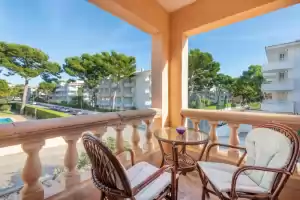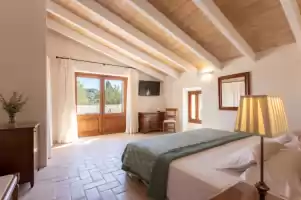The dry stone route in Majorca or dried stone has just turned Cultural Intangible Heritage of Humanity, a route that gives us wonderful scapes and the most amazing hiking routes.
The peculiarity of this millenial building technique is that the stones are stacked up one on other, depending of their shape and size, to get them to stick together without any need of extra material that works as glue.
The fact of not using cement or any other kind of material allows the water to slide in between the stones on rainy days and prevents these walls, called marges or marjades, to end up falling.

Besides, the dry stone technique uses a material that’s very present in the nature, which makes the farmers and breeders to be able to build this walls in a low price, just as cultivating the land on slopes.
The hiking lovers have a must-do route, the route GR 221 or Dry Stone Route, where it is possible to do short walks in an hour and a half or getting to know the island, the landscapes and the costumes deeply through its paths that cheer the hikers to walk for more than 9 hours.
Nowadays, almost all the paths on the Route GR 221 have been restored by the Consell de Mallorca, which makes them totally accessible walking for people all ages wherever which physical condition they’re in, since there are different levels of difficulty.
The dry stone in Majorca is Cultural Intangible Heritage of Humanity.
The title of Cultural Intangible Heritage of Humanty for the dry stone has a main goal: to recognise the importance that these kind of walls still have nowadays, just as keeping this kind of job (marger) alive.
Even though this building technique that has been used since prehistory has always been very important in the Balearic Islands, it also can be appreciated in other places such as Valencia, Andalucia, Aragón, Cataluña and Castilla La Mancha.
The main focus of Dry Stones can be found in the Serra de Tramuntana, which was declared Heritage of Humanity by the UNESCO in 2001.
The municipalies of the Serra de Tramuntana are Alaró, Andratx, Banyalbufar, Bunyola, Calvià, Campanet, Deià, Escorca, Esporles, Estellencs, Fornalutx, Lloseta, Mancor de la Vall, Pollensa, Puigpunyent, Santa Maria del Camí, Sóller and Valldemossa.
It is possible to find dry stoned walls in many places from Mallorca. An example is Fornalutx, a charming town that has amazing villas such as Ca Sa Padrinaor Amarant.
Dry Stone Route in Majorca
The Serra de Tramuntana towns offer some dream views where fields and sea get together to create wonderful landscapes that will make anyone fall in love.
GR 221 or Dry Stone Route
The GR 221 is the main Dry Stone Route due to its more than 270 km that unite Andratx and Pollença on 8 different stages.
First stage: Es Capdellà – Estellencs
The first stage in Route GR 221, or route of the dry stone, starts in Es Capdellà, a mountain village located on the south west of Majorca where it’s possible to breath fresh air and get in touch with nature.
This section goes through places such as Sant Elm and el Coll de sa Gramola until arriving to Estellencs, a small municipality with sea views and deep valleys.
Even though it’s the first stage of our route, it has some parts that still have not been signalled.

Many travellers decide to do the first stage of the Dry Stone Route after having visited Andratx and having relaxed in a holiday villa such as Can Capet.
Second stage: Estellencs – Esporles
In Estellencs the second stage of the Dry Stone Route begins. Its coast is impressive, a section that goes down in between terraces and allow to discover first hand the tradition of the “marjades”.
The road ends in Esporles, a stoned houses and narrow streets little town in where any visitor would love to get lost.
The second stage on this Dry Stone Route deserves a break in Esporles in some pretty villa such as Can Sion.
Third stage: Esporles – Deià
Nowadays the third stage in route GR 221 is only signalled at the beginning, even though in the future it’ll lead the way to follow to get to Deià after going through the famous Camí de s’Arxiduc, a path filled with cliffs that offer a panoramic view o the island and its amazing terraces.
Fourth stage: Deià – Port de Sóller
The fourth stage of the dry stone route can be visited in a little bit more than 3 hours and ends in Port de Sóller after falling in love with magic sceneries such as Faro des Cap Gros or the Chapel de Castelló, this last one built in the XVII century in honor of the Rosary Virgin.

The long walks in Port de Sóller are a must-do for those travellers who decide to visit Mallorca and have the opportunity to stay in some breathtaking villas such as Guitarro.
Fifth stage: Port de Sóller – Escorca
Along this route it is possible to walk through towns such as Sóller or Biniaraix, this last one famous for the route of the Barranc de Biniaraix, a path more than 3km long where it is possible to find wide dry stoned walls.
Sixth stage: Escorca – Lluc
The terraces are also very present in the sixth stage of the Dry Stone Route, that ends up in Lluc so the hikers have the chance to visit a monastery that started to get built in the XII century and is located 400m high: the Verge de Lluc sanctuary.

Seventh stage: Lluc – Pollença
One of the prettiest sections in the seventh stage of the Route GR 221 is El Calvari de Pollença, a mountain from where it its possible to obtain some amazing views of Pollença that can only admire the hikers that dare to go through its 365 steps.
Vacalia can help you to enjoy even more sceneries such as El Calvari de Pollença thanks to some amazing villas such as Calvari.
Eight stage: Pollença – Port de Pollença
The Dry Stone Route, ideal for those who’d like to discover the traditions of Mallorca and jump in its most amazing landscapes while getting to know the terraces, ends up in Port de Pollença, an important touristic spot founded in the XIX century.

If you’d like to discover the wonders of the dry stoned walls and you’ve thought about visiting Mallorca in 2019, pick a holiday villa that adjusts to your needs and remember that you’ll be able to discover this millenial technique through the GR 221 route.





